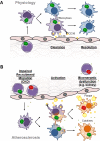Mitochondria in monocytes and macrophages-implications for translational and basic research
- PMID: 24863362
- PMCID: PMC4111987
- DOI: 10.1016/j.biocel.2014.05.019
Mitochondria in monocytes and macrophages-implications for translational and basic research
Abstract
The mitochondrion plays a crucial role in the immune system particularly in regulating the responses of monocytes and macrophages to tissue injury, pathogens, and inflammation. In systemic diseases such as atherosclerosis and chronic kidney disease (CKD), it has been established that disruption of monocyte and macrophage function can lead to chronic inflammation. Polarization of macrophages into the pro-inflammatory (M1) and anti-inflammatory (M2) phenotypes results in distinct metabolic reprograming which corresponds to the progression and resolution of inflammation. In this review, we will discuss the role of the mitochondrion in monocyte and macrophage function and how these cells specifically influence the pathophysiology of atherosclerosis and CKD. We propose that assessing monocyte bioenergetics in different disease states could (1) enhance our understanding of the energetic perturbations occurring in systemic inflammatory conditions and (2) aid in identifying therapeutic interventions to mitigate these disorders in patients.
Keywords: Atherosclerosis; Biomarker; Chronic kidney disease; Macrophage; Monocyte; Oxidative stress.
Copyright © 2014 Elsevier Ltd. All rights reserved.
Figures


Similar articles
-
The role of M1/M2 macrophage polarization in the pathogenesis of obesity-related kidney disease and related pathologies.Front Immunol. 2025 Jan 10;15:1534823. doi: 10.3389/fimmu.2024.1534823. eCollection 2024. Front Immunol. 2025. PMID: 39867890 Free PMC article. Review.
-
The monocyte/macrophage as a therapeutic target in atherosclerosis.Curr Opin Pharmacol. 2009 Apr;9(2):109-18. doi: 10.1016/j.coph.2008.12.017. Epub 2009 Feb 21. Curr Opin Pharmacol. 2009. PMID: 19230773 Review.
-
Monocyte and macrophage immunometabolism in atherosclerosis.Semin Immunopathol. 2018 Feb;40(2):203-214. doi: 10.1007/s00281-017-0656-7. Epub 2017 Oct 2. Semin Immunopathol. 2018. PMID: 28971272 Free PMC article. Review.
-
Immunometabolism orchestrates training of innate immunity in atherosclerosis.Cardiovasc Res. 2019 Jul 1;115(9):1416-1424. doi: 10.1093/cvr/cvz107. Cardiovasc Res. 2019. PMID: 31050710 Free PMC article. Review.
-
Protein Thiol Redox Signaling in Monocytes and Macrophages.Antioxid Redox Signal. 2016 Nov 20;25(15):816-835. doi: 10.1089/ars.2016.6697. Epub 2016 Jul 13. Antioxid Redox Signal. 2016. PMID: 27288099 Free PMC article. Review.
Cited by
-
Loss of Mitochondrial Control Impacts Renal Health.Front Pharmacol. 2020 Dec 9;11:543973. doi: 10.3389/fphar.2020.543973. eCollection 2020. Front Pharmacol. 2020. PMID: 33362536 Free PMC article. Review.
-
Redox biology and the interface between bioenergetics, autophagy and circadian control of metabolism.Free Radic Biol Med. 2016 Nov;100:94-107. doi: 10.1016/j.freeradbiomed.2016.05.022. Epub 2016 May 27. Free Radic Biol Med. 2016. PMID: 27242268 Free PMC article. Review.
-
Considerations for Studying Sex as a Biological Variable in Spinal Cord Injury.Front Neurol. 2020 Aug 5;11:802. doi: 10.3389/fneur.2020.00802. eCollection 2020. Front Neurol. 2020. PMID: 32849242 Free PMC article.
-
Cytochrome c oxidase dysfunction enhances phagocytic function and osteoclast formation in macrophages.FASEB J. 2019 Aug;33(8):9167-9181. doi: 10.1096/fj.201900010RR. Epub 2019 May 7. FASEB J. 2019. PMID: 31063702 Free PMC article.
-
Blood-based bioenergetic profiling: A readout of systemic bioenergetic capacity that is related to differences in body composition.Redox Biol. 2017 Oct;13:418-420. doi: 10.1016/j.redox.2017.06.012. Epub 2017 Jun 30. Redox Biol. 2017. PMID: 28688322 Free PMC article. No abstract available.
References
-
- Aneja A, Tang WH, Bansilal S, Garcia MJ, Farkouh ME. Diabetic cardiomyopathy: insights into pathogenesis, diagnostic challenges, and therapeutic options. Am J Med. 2008;121:748–757. - PubMed
-
- Avila C, Huang RJ, Stevens MV, Aponte AM, Tripodi D, Kim KY, Sack MN. Platelet mitochondrial dysfunction is evident in type 2 diabetes in association with modifications of mitochondrial anti-oxidant stress proteins. Experimental and clinical endocrinology & diabetes : official journal, German Society of Endocrinology [and] German Diabetes Association. 2012;120:248–251. - PMC - PubMed
-
- Bae YS, Lee JH, Choi SH, Kim S, Almazan F, Witztum JL, Miller YI. Macrophages generate reactive oxygen species in response to minimally oxidized low-density lipoprotein: toll-like receptor 4- and spleen tyrosine kinase-dependent activation of NADPH oxidase 2. Circ Res. 2009;104:210–218. 221p following 218. - PMC - PubMed
Publication types
MeSH terms
Substances
Grants and funding
LinkOut - more resources
Full Text Sources
Other Literature Sources
Medical

